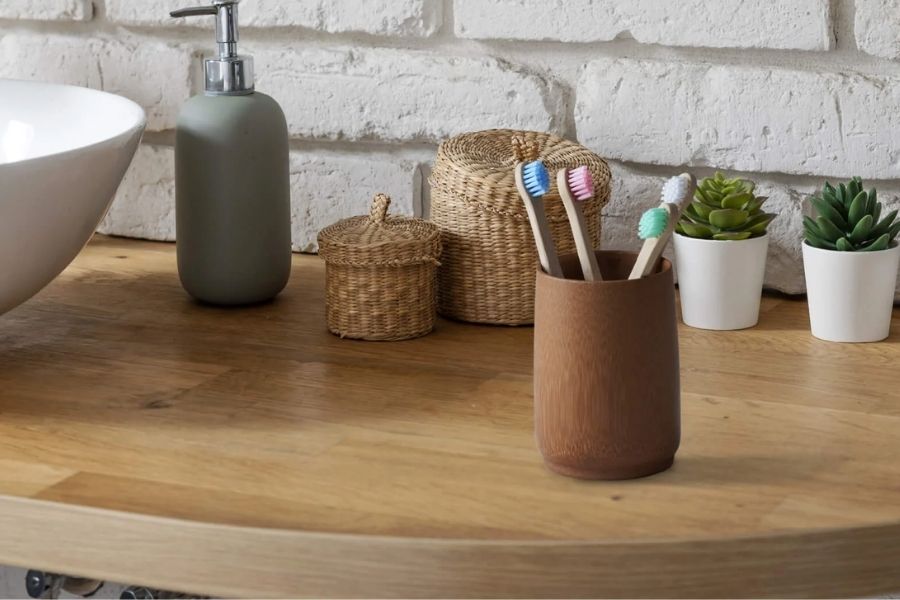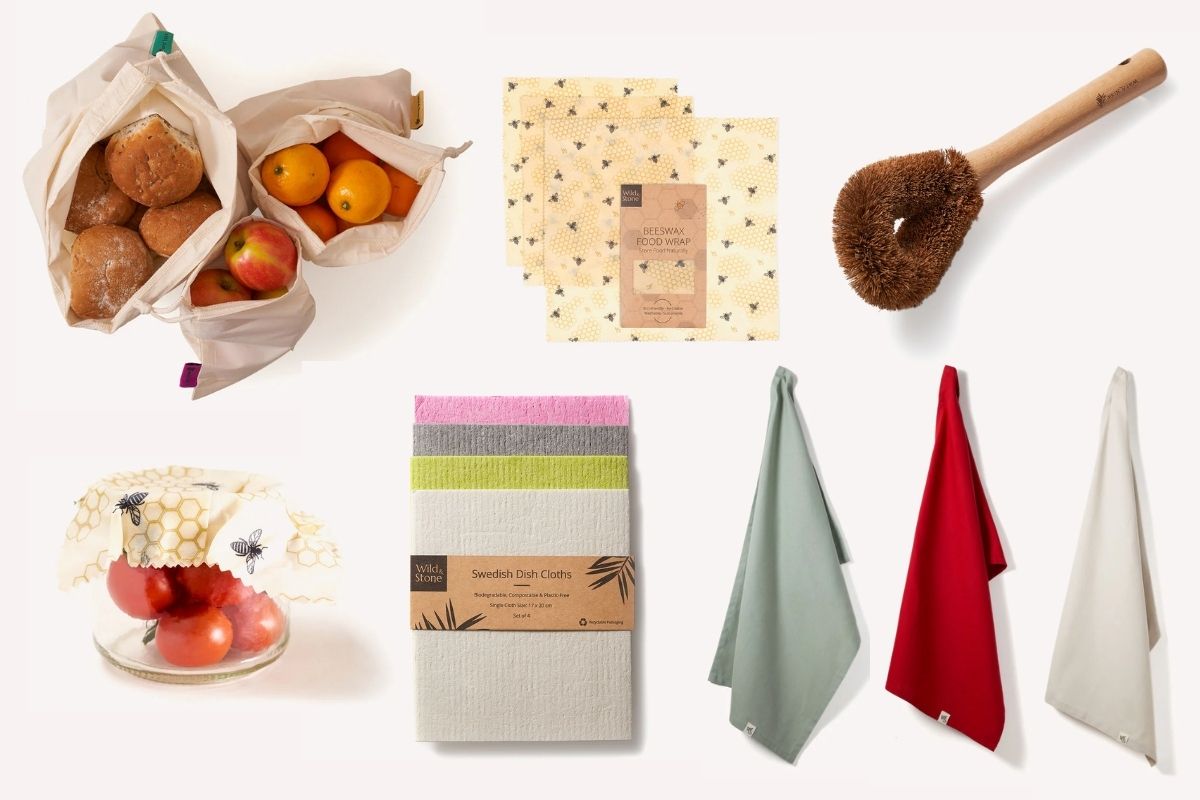Your Cart is Empty
INFO

Everything You Need to Know about Reusable Produce Bags
May 29, 2025 4 min read
Picture this: you pop to the shops for a few bits – some apples, a handful of carrots, maybe a courgette. Each item comes with a plastic bag. Fast forward a few trips, and suddenly your kitchen drawer is overflowing with them.
Sound familiar? This was the reality for people in the UK until the ban on single-use plastic in October 2023, which stopped the sale of single-use plastic if it is not designed or intended for reuse – part of a landmark effort to stop the 2.7 billion plastic items polluting our landscapes each year. The ban covers all plastic types – even "biodegradable" or "compostable" versions – if designed for single use.
While this was a welcome change, it does pose the question: What’s the best way to purchase and store loose fruit, vegetables, bakery items, and other goods? While some supermarkets offer paper alternatives, these aren’t always available, reusable or better for the environment (though these are recyclable, presuming they make it to the right bin).
This is where reusable produce bags come in.
In this guide, our experts share everything you need to know about reusable produce bags, including how to use (and re-use) them, their benefits, and how to make them last.
What is a Reusable Produce Bag?
A reusable produce bag is designed for carrying fresh produce (fruits and vegetables) and other loose or bulk products, such as baked goods, nuts and pasta. It is designed to be reused instead of single-use produce bags.

How to Use (and Reuse) Reusable Produce Bags
Using reusable produce bags is simple.
- Pop your clean reusable bags in your shopping bag or trolley before you leave home.
- Choose your loose produce and pop it straight into your reusable bag.
- Mention the tare - the weight of the bag itself (the "tare weight") is often printed on the tag or label. At the scales or checkout, make sure you subtract the tare weight, so you just pay for the produce inside.
- If your bags have drawstrings or closures, secure them to keep your produce inside.
Once you’re home, pop bags full of potatoes, onions, or garlic into your pantry or cupboard.
In the fridge, a mesh bag helps keep greens and herbs fresher for longer - more on that below.

Outside of their conventional uses, there are loads of ways to use (and repurpose) reusable produce bags.
- Rinse delicate fruits like grapes or berries right in the mesh bag under a gentle tap – it acts like a colander!
- Organise craft supplies.
- Store bath toys (and hang them up to dry).
- Use as a laundry bag for delicates.
-
Repurpose as a wash bag for your travels.
Some peopleeven use them as pans and dish scrubbers or to make homemade fat balls for birds. The possibilities are endless!
Benefits of a Reusable Produce Bag
A good set of reusable produce bags will last you years, and with plenty of benefits to come with it.
- Reusable and durable, for near-unlimited use.
- Breathable to keep your food fresher for longer, reducing food waste.
- Holds heavier loads than plastic.
- Comes with toggle closures to keep your produce secure.
- Biodegradable at the end of their life.
At Wild & Stone, our reusable bags are designed with longevity in mind. Robust stitching, high-quality organic cotton mesh, and clear tare weights mean they perform brilliantly trip after trip, year after year, making that initial cost incredibly worthwhile.
How Long Do Reusable Produce Bags Last?
Exactly how long do reusable product bags last?
With proper care (gentle washing, air drying), cotton and cotton mesh bags will last for several years of regular use.
Silicone bags are durable, lasting decades, but are better suited for airtight storage. Read our posts on Eco-Friendly Food Storage Ideas and How to Store Your Veggies Without Plastic for more on storing food.
How to Wash Your Reusable Produce Bags
Washing reusable produce bags is essential to keep them hygienic, fresh, and long-lasting as it removes soil, bacteria, lingering smells, and prevents mould.
Handwashing or gentle machine washing is recommended at 40 degrees. Tumble drying is NOT recommended - air drying or hanging prolongs the life of cotton/mesh bags.
Aim to wash every 2-3 uses, or immediately if they look soiled or have held something pungent.
One of the best parts of organic produce bags? At the end of their long, useful life, they can often be composted (remove non-biodegradable tags first) or will biodegrade naturally, returning to the earth, unlike plastic.
What is the Best Reusable Bag to Keep Produce Fresh in the Fridge?
Reusable mesh bags, especially cotton ones, allow air to circulate. This reduces excess moisture buildup, lets ethylene gas escape, slowing down over-ripening, and helps to maintain the optimal humidity level for many fruits and vegetables.
The goal is to maintain freshness without promoting rot.
For most items – leafy greens, broccoli, peppers, cucumbers, courgettes – cotton mesh bags are ideal. The airflow prevents excess moisture buildup and slows spoilage.
To keep herbs like coriander or parsley perkier for longer, trim the stems and stand them in a small glass of water inside the mesh bag, or wrap the roots/stems in a slightly damp cloth or paper towel.
Where moisture control is needed, such as with carrots, celery and radishes, place them in a mesh bag with a damp (not soaking) cloth or paper towel tucked inside. This provides humidity without drowning them.

Where Can I Buy Reusable Produce Bags?
Start here! At Wild & Stone, we sell a range of reusable produce bags in both cotton and mesh. The perfect alternative to plastic fruit and veg bags, our produce bags are recyclable and biodegradable.
Our cotton (mesh and non-mesh) bags are made from durable, unbleached organic cotton, Each bag has a colourful label featuring the tare weight, also known as the weight of the produce bag, meaning you can easily calculate the weight of your goods at the checkout of any supermarket or bulk food store. These bags will also keep your produce fresher than their plastic counterparts.

Wild & Stone's mission is to create stylish and easy-to-adapt alternatives to common plastic products around the home. We source all our products sustainably, from raw material to final delivery. Shop all of our sustainable home & lifestyle products on our website, or browse our household collection for more kitchen and bathroom swaps.
Share your plastic-free swaps with us at hello@wildandstone.com or tag us on Instagram #wildandstone.
Also in Sustainable Living Blog

The 5 Benefits of Using a Bamboo Toothbrush
August 07, 2025 4 min read
Discover five benefits of using a bamboo toothbrush, from saving the planet and oral health to the fastest plant in the world.

The 5 Best Eco-Friendly Kitchen Products
July 30, 2025 4 min read
Discover the 5 best eco-friendly kitchen products to take care of yourself, your home & the environment.
Make your inbox a little more eco!
Sign up and save 10% on your first order of 2 items or more.
Keep an eye on your inbox for the latest eco trends, articles, deals and product releases.




